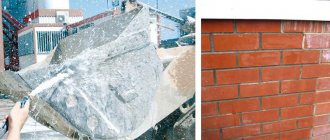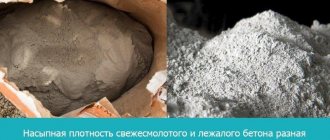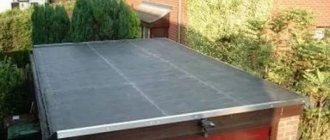The main building material – cement, in addition to its undeniable advantages, has one very significant drawback. Cement is a “perishable” material and cannot be stored “indefinitely” for a long time, including even a relatively short period of time.
The shelf life of cement is several months - on average from 1 to 3 months. However, subject to certain rules, expired material can be successfully used for the construction of non-critical structures.
What is regulated
- GOST 30515-97 “General technical conditions”. Applies to all cements and establishes terms with definitions, classification, general technical safety requirements, rules for acceptance and assessment of quality levels, methods of control, transportation and storage.
- GOST 31108-2016 TU instead of GOST 31108-2003. Applies to general construction cements produced on the basis of Portland cement clinker, and contains requirements for the components of the material composition.
- GOST 30515-2013 “General technical conditions”. Applies to all types of cements and lists terms with corresponding definitions, general technical requirements, safety, sampling for quality control, compliance criteria, transportation and storage, manufacturer's warranties.
Marking
Cement is marked by printing data on the container - a paper bag or big bag. For industrial deliveries in bulk, information is available in the accompanying documents. Lack of marking indicates counterfeit or low-quality raw materials.
Dear readers! To solve your problem right now, get a free consultation
— contact the lawyer on duty in the online chat on the right or call: +7 (499) 938 6124 — Moscow and region.
+7 (812) 425 6761 — St. Petersburg and region. 8 (800) 350 8362 - Other regions of the Russian Federation You will not need to waste your time and nerves
- an experienced lawyer will solve all your problems!
The name of the material from September 1, 2004 is made in accordance with the new GOST (31108-2003 and 31108-2016) and looks like this: CEM III/V-Sh 42.5B. Having deciphered the marking, we get Portland cement with type B additives, additives in the form of granulated slag, strength class after hardening of 42.5, fast-acting. The given example indicated the marking parameters:
- type of product;
- type of cement;
- type of additives;
- strength class;
- normative document.
Before the adoption of the new GOST 2003, and subsequently 2016, marking was carried out on the basis of GOST 1985 and had the following form: PC 500-D0-B - GF GOST 10178-85. Not all standard building materials, reference books, and technical literature used in practice today have been reissued, so they contain the old markings: M 200, M 300, M 400, M 500.
Important: new markings are recognized as legal in the Russian Federation!
GOST standards establish storage time, but do not oblige the production date to be marked on the container. Enterprises indicate it in the delivery note. When purchasing a large quantity, you must check with the seller.
The marking contains the manufacturer’s details and trademark data; mass; when selling colored cement - the corresponding strip on the packaging.
conclusions
To summarize, to maintain quality at the proper level, it is necessary to ensure 5 components:
- optimal humidity level;
- tightness of the packaging (ideally, these are bags made of thick multi-layer paper, wrapped in polyethylene);
- positive room temperature;
- properly arranged rack.
If the powder for preparing the solution is unsuitable, it will no longer be possible to correct the situation. Such solutions cannot be used in construction.
Sources
- https://remontsupers.ru/srok-godnosti-tsementa-m500-po-gostu/
- https://PoPravu.club/tovar/sroki-godnosti/neprodovolstvennye/tsementa.html
- https://karniz-dv.ru/rabochie-processy/srok-godnosti-cementa.html
- https://udarnik.spb.ru/articles/vse-o-cemente/hranenie-cementa/
- https://srok-godnosti.ru/prochee/hranenie-tsementa-srok-godnosti-v-meshkah-po-gostu
- https://profhranenie.ru/srok-godnosti-tsementa
- https://bbpi.ru/vidy-betona/srok-hraneniya-cementa-v-meshkah.html
- https://www.VosCem.ru/articles/shelf-life-of-cement/
- https://m-strana.ru/blog/post/poleznaya-informatsiya/56098/pravila-khraneniya-tsementa-v-techenie-garantirovannogo-i-realnogo-sroka-godnosti-64514/
- https://pinta-pub.ru/pishcha/kak-pravilno-hranit-cement.html
- https://ipk-rotor.ru/proizvodstvo-betona/srok-godnosti-tsementa-v-bumazhnyh-meshkah-50-kg.html
- https://masterfibre03.ru/tehprocessy/kak-hranit-cement-zimoj-v-holodnom-garazhe.html
- https://strop-snab.ru/raznovidnosti/srok-godnosti-betona.html
- https://salesbeton.ru/proizvodstvo-betona/srok-godnosti-czementa-v-bumazhnyh-meshkah-50-kg
- https://sib-bastion.ru/processy/kak-hranit-cement-v-meshkah.html
- https://1nerudnyi.ru/kak-hranit-tsement-zimoj-01/
- https://melt-spb.ru/raboty-s-betonom/srok-godnosti-cementa-m400.html
- https://prostroymat.ru/tsement-m400-sroki-khraneniya/
What is he like?
| Brand | Tara | Weight, kg) | Expiration dates (days) | |
| guaranteed | real | |||
| TsEM I 42.5N-M500 | Polyethylene bags | 25 | 60 | 30 |
| Paper containers | 50 | 60 | 30 | |
| Loose, without sealed packaging | No limit | 45 | 20 | |
| TsEM I 32.5N-M400 | Big bags | 400 -2000 | 60 | 30 |
| Five-layer valve bags | 50 | 60 | 30 | |
| Loose, without sealed packaging | No limit | 45 | 20 | |
| TsEM I 22.5N-M300 | Polyethylene bags | 25 | 60 | 30 |
| Paper bags | 50 | 60 | 30 | |
| TsEM I 12.5N-M200 | Paper containers | 50 | 60 | 30 |
Shelf life is the period during which the material retains its specified properties. If it is overdue, the cement becomes unsuitable for use. This period indicates the product is of proper quality and establishes a ban on sale after the expiration of the specified period. There are guaranteed and real terms.
Important: expired cement cannot be used in construction!
Guaranteed
According to clause 5.1. GOST 10178-85 the manufacturer guarantees the shelf life:
- in containers - 45 days after shipment for quick-hardening ones;
- 60 days - for other cements;
- when supplied in bulk - no more than 45 days after shipment for quick-hardening ones and 60 days for others.
The indicated periods take place subject to strict adherence to the rules of transportation and storage.
Real
Carbon dioxide, high humidity, and lack of ventilation in storage areas leave their mark on the quality of the building material. If all storage standards are observed, cement packed in bags loses 15% of its effect every month.
The higher the grade, the faster the substance loses its properties. Portland cement M 500 after 2 months can only be classified as M 400.
Stamps
There are several grades of cement with different purposes: M 500, M 400, M 300, M200. The higher the number, the greater the activity of the material, the stronger the building mixture.
The established period of time for storage depends not on its brand, but on the packaging container and storage technology.
The guaranteed shelf life for packaged material is 60 days, and in bulk - 45. The actual shelf life is 30 days for all brands of packaged cement, 20 - without it.
Tara
Cement is packaged in two ways: in bags weighing 50 kg and in big bags from 400 to 2000 kg. The bags consist of five- or six-layer paper and have a closed neck with a valve. The use of imported bags is allowed. In retail trade, for small packaging, plastic bags and cans are used.
Weight
The packaging is designed for a load of 50 kg, the permissible gross weight is 51 kg.
Soft modern industrial containers made from vacuum packaging are big bags. They hold from 0.4 to 2 tons of bulk material. The container has a sealing liner made of polyethylene; there are sewn-in slings for lifting operations. The container is completely insulated from moisture.
Polyethylene bags are small packaging, their weight is up to 25 kg. Cans and bags of lighter weight are used in retail trade.
The net weight of the package and the permissible error must be:
- 50 kg - 1 kg on both sides of the net;
- 0. –2 tons – +2. –1% of net;
- 10, 20 kg - 0.3 kg on both sides of the net;
- 3–5 kg - 0.05 kg from net.
If the permissible weight limits of GOST 30515-97 are violated, there is doubt about purchasing the material of the declared quality.
Each container is designed for certain conditions and volumes of work and the possibility of transportation.
Purchase Features
The manufacturer must ensure strict control of the cement acceptance process. As a rule, in production conditions these activities are carried out by the technical control service. The purchase of bulk cement by the buyer is recommended only for rapid large-scale work. It is more practical to buy the mixture packaged in bags. The most popular loads among construction contractors are 50 kg packs. It is more expedient to purchase cement immediately before construction work in small quantities. You should check the integrity of the paper container and pay attention to the date of manufacture. Basements, cellars, or outdoor placement under a canopy are absolutely not suitable for storage. The optimal room is a stone building with heating and ventilation.
Shelf life of concrete
The durability of concrete varies between 50–100 years, depending on operating conditions. When describing the properties of concrete, its production indicator according to GOST 26633-2012 is strength, the ability to withstand specified loads. The shelf life of concrete is determined only by practical means.
The key to durability is the correct choice of concrete brand, additives, binders, and fillers. A building material may have the following properties: frost resistance, water resistance, abrasion resistance.
If the manufacturing and laying technology is followed, concrete does not rot, does not rust, is not afraid of moisture, heat, and can be in the ground.
The foundations of buildings in the northern capital of the country are constantly damp, but, having stood for many years, they have not lost their strength and reliability.
Options for using expired or damaged cement: all the pros and cons
There is an opinion that crushed fossilized cement can be used along with fresh cement in a 1:1 ratio. They also say that it is not bad as sand in construction mixtures and is great for blind areas. All of the above is complete nonsense. However, such building material can indeed be used, but only in a slightly different way.
Depends on storage conditions
The property of cement to quickly respond to moisture is its advantage and disadvantage at the same time. The shelf life depends entirely on the human factor, that is, on the conditions created by it.
According to GOST 30515-97, this time ranges from 45 to 60 days. The room should be dry, ventilated, without drafts.
Sacks and big bags are stored on wooden pallets in stacks at a distance of 10 cm from the floor. If storage involves a period of more than 6 months, it is necessary to use a polymer film. Ideally, each container should be packaged separately. Industrial storage takes place in silo containers with a wooden bottom or in a hermetically sealed container.
What are the packaging requirements?
Must be sealed. Even a small gust will expose it to air, causing the material to harden and become unusable. Cement is packed in kraft paper bags. Disposable plastic bags and big-bag polypropylene containers have become popular.
Long-term storage
The shelf life is determined to be 1 year, after which the astringent properties of the material disappear completely. If the flowability is not lost, it can be used as a filler for a concrete mixture.
The application starts from the moment of shipment to the consumer. Each month, active properties decrease by 15%. Cement has a limited time period; it is not recommended to stock it for future use.
Storage is carried out on pallets at a distance of 30 cm from the ground, the height of the stack does not exceed 2 m. Storing bags with different material markings in the same stack is prohibited.
Winter
The temperature in the warehouse should be +5 ˚С and above. A dry, ventilated, draft-free room is suitable for storage. To prevent contact with moisture, the container is additionally packed with polyethylene except for the sides directed towards the air flow.
Important: cement cannot be stored in an open area in winter. Cold and damp will turn him to stone. Use polyethylene!
Summer
In summer, you need to protect the material from precipitation and dampness of the ground. Storage is carried out on pallets. When storing in an open area, the bags are covered with polyethylene.
How to properly store in winter and summer?
To store the material both in winter and summer, a dry and ventilated room is required. It is important to observe the temperature regime (you need to maintain the temperature regime).
The cement should be placed on pallets, the distance from the bag to the ground should be at least 30 centimeters . Each bag is hermetically wrapped in cellophane film. In summer, the bags can be stored outdoors for some time, after laying water-repellent material between them.
Cement storage is prohibited in places such as:
- open canopy;
- basement;
- unheated rooms with high moisture content.
The ideal storage location is a sealed room with minimal humidity.
You can learn how much and how to store cement correctly from the video:
You will find recommendations for obtaining a building permit on our website.
How to know what is unsuitable
You can determine the suitability of cement before purchasing by tapping the bag.
If moisture gets inside, the hardened area can be identified by touch. Also, when squeezed in a fist, the bulk material will crumble freely, which means it can be used. Stale goods will turn into a lump.
Is it possible to use expired
It loses its commercial properties, and using it as a binding component in construction is not only impossible, but simply dangerous.
If this happens, you can find two ways to use it:
- use hardened pieces as rubble when pouring the foundation;
- Use the crumbly substance as a filler in the solution.
How long can an opened package of cement be stored?
In private home construction or during repairs, situations arise when only a little powder is needed from the bag for mixing. What to do with the rest of the cement? It is correct to store it in a tightly (if possible) sealed bag in a cool, dry place. Fold the free edge several times and seal with tape.
But even in such conditions, the previous shelf life is no longer relevant - the remaining binder can only be used within a few days.
It is no longer possible to use such a “stale” component for the manufacture of load-bearing and structural elements. In addition, before removing any leftovers from the package, evaluate their suitability: the powder should be dry and free-flowing without the slightest sign of moisture. This is suitable for preparing plaster, creating bedding layers and solving other auxiliary tasks.











